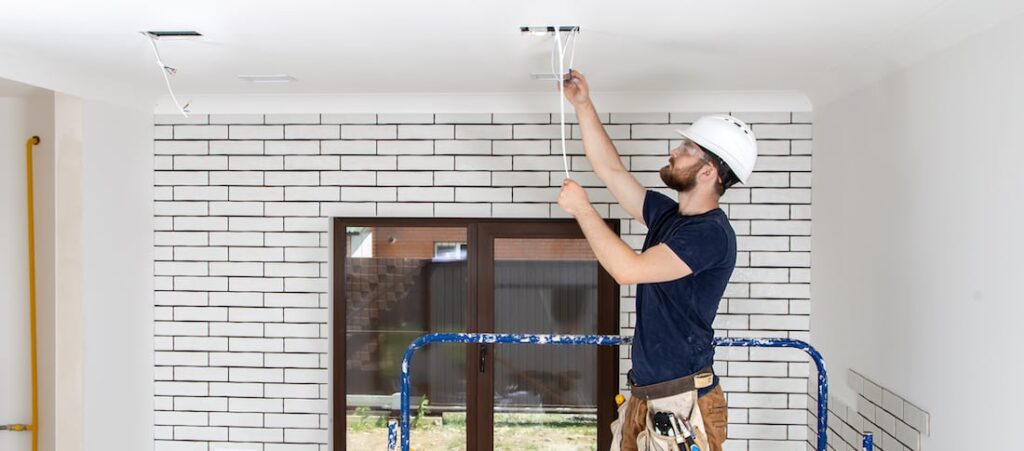“Rough-in” wiring means that all the electrical cables have been pulled through the studs of the wall and that boxes for light switches, outlets, and receptacles have been placed. But the wiring has not been connected to your breaker box and the various switches, outlets, and receptacles have not yet been installed. With the information provided here and some basic tools, you can do rough-in wiring yourself and save some money on your project. In this post, we’ll help you learn how to do your own rough-in wiring job.
Are you adding an addition to your home? How about finishing a basement or building a standalone studio, garage, or shed? In all these cases you’ll want to wire the new construction for electricity. Did you know you can save money by doing much of the electrical wiring yourself?
“Rough-in” wiring means that all the electrical cables have been pulled through the studs of the wall and that boxes for light switches, outlets, and receptacles have been placed. But the wiring has not been connected to your breaker box and the various switches, outlets, and receptacles have not yet been installed. With the information provided here and some basic tools, you can do rough-in wiring yourself and save some money on your project. In this post, we’ll help you learn how to do your own rough-in wiring job.
A smart first step is to sketch out your wiring on paper before you begin working. Think about your electrical needs as you do this. For example, how many overhead lightboxes do you want? Where will position light switches? How many electrical outlets do you need and where do you want them to be located?
Evaluate your existing wiring
If you’re adding on to existing wiring, it’s important to check the capacity of the original circuit and line so that you aren’t overloaded. Lower amperage circuits served by a 15-amp circuit breaker, for example, may not be up to the additional load of extra outlets or lighting fixtures. Consult with a qualified electrician if you have any questions.
Check building codes
Local and national building and electrical codes must be followed when installing new wiring. You should be familiar with the basics of these before you begin. The codes cover many important aspects of your installation, including but not limited to wiring gauge, the size of receptacle boxes, and the details of how wires are routed and mounted in your walls. Be sure to check with a qualified electrician to make sure that you know the requirements that apply to your specific job.
Get the tools and materials you need
You’ll need the right tools and materials to tackle the job. Here’s a checklist of the tools required:
Depending on your job you’ll need some or all of these materials:

Now that you’ve sketched out your plans, consulted with a professional, and purchased your tools and materials, it’s time to take the next steps and get working on the rough-in.
You’ll install your boxes on the studs of the wall. If necessary to move the box a bit further away from a doorway or window, you can nail a block of 2x4 to the stud. Mark the stud where the center of the box will be located. The convention is for switches to be 48” above the floor, and outlets 12” up. Make a mark on the stud as to what type of box goes in that location.
Center each box on the mark you’ve made and nail it to the stud. It’s important that the boxes extend out in front of the stud so that the front edge of the box will be flush with the wall covering you’ll be using. In most cases, that’s drywall, which is 1/2”. Therefore the box will stick out 1/2” from the stud when properly mounted. If you’re using a different wall covering, measure and adjust accordingly.
Pro tip
Most boxes will have a line or guide marked on the side for use with standard 1/2” drywall. This will prevent extra measurements and help you align the box properly.
This is where your investment in a 3/4” spade drill bit will pay off. Begin drilling holes along the path of your wiring, about 8” above the level of the outlets. Make sure the holes are at least 1-¼” behind the front of the stud. If they’re closer, install a metal nail plate in front of the hole to protect the cable.
Pro tip
To keep the holes in line with each other, mark the studs with a pencil or chalk line before you begin drilling. It’s easier to run the cable through a straight line of holes.
Now you’ll run the cable between the box locations. Straighten out 10-12 feet of cable from your cable roll. Starting at the stud holes by one box, push the end of the cable through the holes in the studs until you reach the location of the next box. Cut back about 8 inches of the outer cable sheathing to expose the wiring, but don’t remove the insulation on the inner wires. Push the cable into the box until about 1/4” of the cable sheathing is in the box. Repeat this process on the other end, at the first box.
Pro tip
Leave a little bit of slack in the cable run between the boxes, in case the cable needs to be moved slightly to accommodate pipes or ductwork. When in doubt, leave a little extra wire. It’s easier to trim back a little excess wire than make an entirely new run if you come up short.
Cables that follow the studs to your boxes should be stapled to the studs using cable staples. Place the cable staples far enough back from the boxes to allow the cable some slack.
Pro tip
Make sure your cable is laying flat against the stud when you secure it. If the cable is at right angles to the stud, it may be pinched and damaged by the cable staple.
When you’ve made all the cable connections between the boxes, make your final run to the cable box. At the cable box, leave about 4 feet of extra cable so that your electrician has plenty of extra cable to work with when they connect the circuit up to the breaker.
Pro tip
Avoid long spans of unsupported wiring. If you can’t run the cable through the studs, attach the cable to the studs with cable staples at regular intervals.
Once you’ve run all the cables to each box, group together all the wires of the same color. Bundle them together with some tape or a zip tie, and mark what the circuit is for. This will make hooking up the switches and outlets easier.
Roughing in the electrical wiring to your new addition or building is a job that’s well within the reach of the dedicated do-it-yourselfer. And you’ll not only save some money, but you’ll also gain a better appreciation of how the electrical wiring in your home distributes power to your outlets and switches.
Do you have an electrical job that needs to be done in your home? You can take pride in doing some basic electrical jobs yourself, but you may find that professional help or consultation is required for some jobs. When that’s the case, you should work with professionals who know the ins and outs of residential plumbing. At Team Enoch all our electricians are specially trained, state-licensed, fully insured and background checked. We can handle any size job and we warranty all of our work. If you live in the Dallas Fort Worth Metro area don't hesitate to contact us.
Whether it’s new home wiring, electrical installations, standby generators, EV chargers, or anything else electrical in your home, contact us. Remember, estimates are always free!
